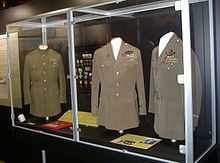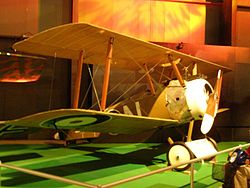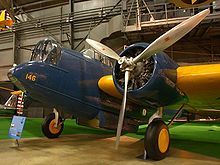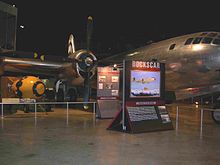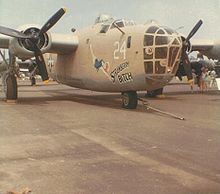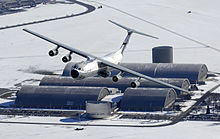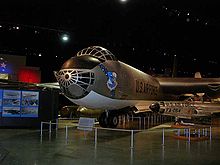- National Museum of the United States Air Force
-
Coordinates: 39°46′55″N 84°06′32″W / 39.781976°N 84.108892°W
National Museum of the United States Air Force 
Established 1923 Location Wright-Patterson Air Force Base,
Dayton, OhioType Aviation museum Visitor figures 1,000,000+[1] Director Lt. Gen. John L Hudson, USAF (retired) Curator Terry Aitken Public transit access Greater Dayton RTA Route 11 Website www.nationalmuseum.af.mil The National Museum of the United States Air Force (formerly the United States Air Force Museum) is the official National Museum of the United States Air Force and is located at Wright-Patterson Air Force Base, near Dayton, Ohio. The NMUSAF is the world's largest and oldest military aviation museum.[2] More than 360 aircraft and missiles are on display, most of them indoors.[1] The museum draws over 1.3 million visitors per year and is one of the single most visited tourist attractions in Ohio.[3] Admission is free.
Contents
- 1 History
- 2 Exhibits and collections
- 3 Future developments
- 4 Partial list of collection
- 5 Air Force Museum Foundation
- 6 Other Air Force museums
- 7 See also
- 8 References
- 9 External links
History
The museum dates back to 1923 when the Engineering Division at Dayton's McCook Field first collected technical artifacts for preservation. In 1927 it moved to then-Wright Field and was housed in a succession of buildings. In 1954 as the Air Force Museum it was housed in its first permanent facility, Building 89 of the former Patterson Field in Fairborn, which had been an engine overhaul hangar, and many of its aircraft were parked outside and exposed to the weather. It remained there until 1971 when the current facility was first opened. Not including its annex on Wright Field proper, the museum has more than tripled in square footage since its inception in 1971.[4]
Exhibits and collections
The museum's collection contains many rare aircraft of historical or technological importance as well as various memorabilia and artifacts relating to the history and development of aviation. Included in the permanent collections are one of four surviving Convair B-36s, the only surviving XB-70 Valkyrie, and Bockscar—the B-29 Superfortress that dropped an atomic bomb on Nagasaki during the last days of World War II.
The museum launched their 360-degree Virtual Tour in 2010. Visitors can now view the majority of the museum's aircraft and exhibits online.
Presidential aircraft
The museum has several Presidential aircraft, including those used by Franklin D. Roosevelt, Harry Truman, and Dwight D. Eisenhower. The centerpiece of the Presidential aircraft collection is SAM 26000, a modified Boeing 707 used regularly by Presidents John F. Kennedy through Richard Nixon during his first term; after which it served as the backup Presidential aircraft. This was the aircraft that took President and Mrs. Kennedy to Dallas on November 22, 1963—the day of the President's assassination. Vice President Lyndon B. Johnson was sworn in as president aboard it shortly after the assassination; this aircraft then carried the slain President's body back to Washington.[5] It was temporarily removed from display on December 5, 2009, to be repainted. It was placed back on display in the museum on President's Day, 2010.[6] All presidential aircraft are now on display in their own Presidential Hangar next to the R&D/Flight Test Hangar which are both located west of the USAF Museum. As both hangars are behind the perimeter fence on Wright-Patterson AFB property, they are only accessible to the general public by tour bus.
Pioneers of flight
There is a large section of the museum dedicated to pioneers of flight, especially the Wright Brothers, who conducted some of their experiments at nearby Huffman Prairie. A replica of the Wrights' 1909 Military Flyer is on display, as well as other Wright brothers artifacts. The building also hosts the National Aviation Hall of Fame, which includes several educational exhibits.
Uniforms and clothing
The museum has a large inventory of USAAF and Air Force clothing and uniforms in its collection. At any time over fifty WWII vintage A-2 leather flying jackets are on display, many of which belonged to famous figures in Air Force history. Others are beautifully painted to depict the airplanes and missions flown by their former owners. Included in the museum's displays are the jacket worn by Brig. Gen. James Stewart, P-38 ace Maj. Richard I. Bong's sheepskin B-3 jacket and boots, an A-2 jacket worn by one of the few USAAF pilots to leave the ground during the attack on Pearl Harbor, and President Ronald Reagan's peacoat.
Other exhibits and attractions
The museum completed the construction of a third hangar and hall of missiles in 2004. It now houses post-Cold War era planes such as the B-2 Spirit stealth bomber (test aircraft), the F-117 Nighthawk stealth ground attack aircraft and others. Fund raising has begun for a fourth hangar to house the museum's space collection, presidential planes and an enlarged educational outreach area, making all more accessible to the public.
The museum has an IMAX theater that shows, for a fee, aviation and space oriented IMAX films interspersed primarily with other documentaries.
The museum owns other aircraft that are on loan to other aerospace museums in the United States. Most of these loaned aircraft duplicate aircraft exhibited by the museum. The museum's staff has very high standards for the quality of care/restoration of loaned assets, and has, in the past, revoked these loans when it was deemed that these other museums did not have the resources to properly care for an artifact. This happened in the case of the famous B-17, Memphis Belle.
Future developments
The Museum is currently raising funds for the construction of a fourth hangar gallery to be built behind the current Missile Gallery. The project is expected to cost $40,000,000. When completed it will house all the Museum's research and development aircraft as well as the presidential aircraft, freeing those hangars for use in future restoration projects, as well as the eventual display of the Convair XC-99.
Partial list of collection
The museum is divided into galleries, covering broad historic trends in military aviation. These are further broken down into exhibits detailing specific time periods and showing aircraft in their historical context.
All aircraft in this list were designed/built in the United States of America, unless otherwise indicated.
Early Years Gallery (1901–1941)
Early years (1901–1917)
- Wright Brothers 1901 wind tunnel
- Wright Military Flyer (1909), the first aircraft ever purchased by the U.S. Army Signal Corps
- Curtiss 1911 Model D, the second aircraft purchased by the Signal Corps
- Wright Brothers 1911 wind tunnel
- Blériot Monoplane (France)
World War I (1917–1918)
- SPAD VII (France – used by U.S. Lafayette Escadrille)
- Curtiss JN-4D "Jenny" trainer
- Standard Aircraft SJ-1 trainer
- Thomas-Morse Aircraft S-4C Scout trainer
- Avro 504K trainer
- Nieuport 28 C.1, used by the first fighter squadrons of the United States Army Air Service (USAAS)
- Sopwith F-1 Camel (Great Britain, used by the United States Army Air Service)
- Fokker Dr.I (Germany)
- Caquot Type R observation dirigible (France – used by United States Army)
- Halberstadt CL.IV (Germany)
- SPAD XIII (France) – donated by Old Rhinebeck Aerodrome upon the passing of Cole Palen
- Fokker D.VII (Germany)
- Kettering Bug Aerial Torpedo (U.S – First cruise missile)
- Caproni Ca.36 (Italy)
Inter-War years (1919–1941)
- De Havilland DH-4 (U.S. built from a British design)
- Martin MB-2 (First U.S. designed bomber)
- Consolidated PT-1 "Trusty" (trainer)
- Boeing P-12E
- Curtiss P-6E
- Boeing P-26A Peashooter
- Martin B-10
- Douglas O-38F
- Douglas O-46A – currently in storage
- North American O-47B
- Curtiss O-52 Owl
- North American BT-9B (trainer)
- Stearman PT-13D Kaydet (trainer)
- Fairchild PT-19 Cornell (trainer)
World War II
Attack Aircraft
- Douglas A-20G Havoc
- Douglas A-24B Banshee
- North American A-36A Apache
Bomber Aircraft
- Boeing B-17D Flying Fortress 40-3097 "The Swoose" – under restoration
- Boeing B-17F Flying Fortress 41-24485 "Memphis Belle" – under restoration
- Boeing B-17G Flying Fortress 42-32076 "Shoo Shoo Baby "
- Douglas B-18 Bolo
- Douglas B-23A Dragon – currently in storage
- Consolidated B-24D Liberator "Strawberry Bitch" 42-72843
- Martin B-26G Marauder
- Boeing B-29 Superfortress "Bockscar" – Aircraft used in atomic bombing on Nagasaki
Cargo Aircraft
- Douglas C-39 – currently in storage
- Curtiss C-46D Commando
- Douglas C-47D Skytrain
Photographic Reconnaissance Aircraft
- North American F-10D Mitchell 43-3374 – (Painted as B-25B – Doolittle Raider's diorama)
Liaison Aircraft
Multi-Purpose Aircraft
Rotary Aircraft
Pursuit Aircraft
- Seversky P-35
- Curtiss P-36A Hawk
- Lockheed P-38L Lightning
- Bell P-39Q Airacobra
- Curtiss Hawk 87A-3 (P-40E) AK987 – (Flying Tigers markings)
- Republic P-47D-15RA "Fiery Ginger" 42-23278 (razorback)
- Republic P-47D-40RA "Five by Five" 45-49167 (bubble-top)
Trainer Aircraft
- Curtiss AT-9 Jeep (advanced trainer)
- Vultee BT-13 Valiant (basic trainer)
- Ryan PT-22 Recruit (primary trainer)
Foreign Aircraft
- Noorduyn UC-64A Norseman (Canada)
- Bristol Beaufighter Mk Ic (Great Britain)
- De Havilland DH 82A Tiger Moth (Great Britain)
- De Havilland DH 98 Mosquito Mk 35 (Great Britain)
- Hawker Hurricane Mk IIa (Great Britain)
- Supermarine Spitfire Mk Vc (Great Britain)
- Supermarine Spitfire Mk PRXI (Great Britain)
- Kawanishi N1K-J Shiden-Kai "George-21" (Japan) –
- Mitsubishi A6M2 "Zeke" (Japan)
- Yokosuka Ohka Trainer (Japan)
- Fieseler Fi 156C-1 Storch (Germany)
- Focke-Wulf Fw 190D-9 (Germany)
- Junkers Ju-88D-1 (Germany)
- Messerschmitt Bf 109G-6 610824 (Germany)
- Messerschmitt Me 163B Komet (Germany)
- Messerschmitt Me 262A Schwalbe (Germany)
- Fieseler Fi 103 (V-1) (Germany)
- V-2 with Meillerwagen (Germany)
- Macchi MC.200 Saetta (Italy)
Korean War
- Douglas A-26C Invader
- Douglas C-124C Globemaster II
- Fairchild C-82 Packet
- Fairchild C-119 Flying Boxcar
- Lockheed F-80C Shooting Star (First operational U.S. jet fighter)
- Lockheed F-94A Starfire
- Mikoyan-Gurevich MiG-15bis (USSR – this aircraft was landed in Seoul by No Kum-Sok, a Korean People's Air Force, supposedly influenced by Operation Moolah and later test flown by Chuck Yeager in Japan)
- North American B-45C Tornado
- North American F-82B Twin Mustang
- North American F-86A Sabre
- North American RF-86 Sabre
- North American T-6 Mosquito (forward air control version of T-6 Texan trainer)
- Republic F-84E Thunderjet
- Sikorksy YH-5A
- Sikorsky UH-19B Chickasaw
Southeast Asia War
- Bell UH-1P Iroquois
- Boeing B-52D Stratofortress
- Cessna YA-37A Dragonfly
- Cessna O-1G Bird Dog (forward air control)
- Cessna O-2A Skymaster (forward air control)
- De Havilland Canada C-7 Caribou
- Douglas A-1E Skyraider
- Douglas RB-66B Destroyer
- Fairchild C-123K Provider "Patches"
- General Dynamics F-111A Aardvark
- Kaman HH-43B Huskie
- Lockheed EC-121D Warning Star
- Lockheed C-141 Starlifter Hanoi Taxi
- Ling-Temco-Vought A-7D Corsair II
- Martin EB-57B Canberra (U.S. manufactured version of British design)
- McDonnell RF-101 Voodoo
- McDonnell Douglas F-4C Phantom II
- Mikoyan-Gurevich MiG-17 (USSR)
- Mikoyan-Gurevich MiG-21PF (USSR) (a second MiG-21 is in storage)
- North American F-100F Super Sabre
- North American OV-10A Bronco
- Northrop YF-5A Skoshi Tiger
- Republic F-105D Thunderchief (besides the fighter version, there is also a Wild Weasel F-105G version on display)
- Sikorsky CH-3E
Cold War
- Avro Canada CF-100 Canuck (Canada)
- Boeing RB-47H (reconnaissance variant)
- Boeing WB-50D Superfortress (weather reconnaissance variant)
- Boeing KC-97L Stratotanker (aerial refueling tanker)
- Convair B-36J "Peacemaker"
- Convair B-58 Hustler
- Convair F-102A Delta Dagger
- Convair F-106A Delta Dart (Cornfield Bomber)
- De Havilland Canada U-6A Beaver
- Dassault Mystere IVA (France) – currently in storage
- Douglas C-133 Cargomaster
- Lockheed F-104C Starfighter
- Lockheed SR-71A Blackbird
- Lockheed U-2A
- McDonnell F-101 Voodoo
- Mikoyan-Gurevich MiG-19S (USSR)
- Mikoyan-Gurevich MiG-23 (USSR) – two currently in storage
- Mikoyan-Gurevich MiG-25 (USSR) – currently undergoing restoration
- Northrop F-89 Scorpion
- Piasecki CH-21B Workhorse
- Republic F-84F Thunderstreak
- Sukhoi Su-22M-4 (USSR) – currently in storage
- Northrop AT-38 (United States)
Post Cold War
- McDonnell Douglas F-15 Eagle
- Mikoyan MiG-29 (USSR)
- Northrop B-2A Spirit (static test mock-up)
- Northrop Grumman RQ-4 Global Hawk
- Panavia Tornado GR4 (Royal Air Force)
- Rockwell B-1B Lancer
Missile and Space Gallery
- Apollo 15 Command Module
- Gemini B experimental capsule for the Manned Orbiting Laboratory
- Jupiter IRBM
- Thor IRBM
- Titan I ICBM
- Titan II ICBM
- Minuteman III ICBM
- Agena SLV
- Peacekeeper ICBM
Presidential aircraft
- Douglas VC-54C Sacred Cow
- Used by Franklin Delano Roosevelt and first 27 months of Harry Truman's administration
- The National Security Act of 1947, creating the United States Air Force, was signed aboard this aircraft [7]
- Douglas VC-118 Independence
- used by Harry Truman
- Lockheed VC-121E Columbine III
- Used by Dwight D. Eisenhower
- Bell UH-13J Sioux
- Used by Dwight D. Eisenhower and John F. Kennedy
- Boeing VC-137C – SAM 26000 (Boeing 707 – first aircraft called Air Force One)
- Used by John F. Kennedy, Lyndon Johnson, and Richard Nixon during his first term.
- Beech VC-6A Lady Bird Special (King Air B90)
- Used by Lyndon Johnson for frequent trips from Austin, Texas to LBJ Ranch
- Aero Commander U-4B (military version of L-26 Aero Commander)
- Used by Dwight D. Eisenhower from 1956 to 1960 for short trips
- North American T-39A Sabreliner
- Used to transport Lyndon Johnson after leaving office
- Lockheed VC-140B JetStar
- Used by Richard Nixon, Gerald Ford, Jimmy Carter and Ronald Reagan for trips requiring a smaller aircraft
Research and development aircraft
- American Helicopter XH026 Jet Jeep
- Avro Avrocar
- Bell P-59B Airacomet
- Bell X-1B
- Bell X-5
- Bell XV-3
- Boeing Bird of Prey
- Boeing EC-135 Stratolifter (modified) ARIA Bird of Prey
- Boeing X-32 Joint Strike Fighter – currently in storage
- Boeing X-45 Unmanned Combat Air Vehicle
- Convair XC-99 – currently undergoing restoration
- Convair XP-81 – two currently in storage
- Convair XF-92A
- Curtiss-Wright X-19 – currently in storage
- Douglas X-3 Stiletto
- Fisher P-75A Eagle
- Grumman X-29A
- Lockheed YF-12A
- Lockheed YF-22 – removed from display and replaced w/ EMD Raptor
- Lockheed NT-33A
- Lockheed X-7A
- Lockheed XF-90A – currently in storage
- LTV XC-142A (Tiltwing research)
- McDonnell XF-85 Goblin
- McDonnell Douglas YF-4E – currently in storage
- McDonnell Douglas F-15 Streak Eagle (time-to-climb record holder) – currently in storage
- NASA/Boeing X-36
- Martin Marietta X-24B
- North American Aviation Apollo 15 Command Module
- North American XB-70 Valkyrie
- North American F-107A
- North American X-10
- North American X-15 (Hypersonic record holder)
- Northrop Tacit Blue (Whale) (stealth low observable demonstrator)
- Northrop YF-23 Black Widow II – recently put on display
- Northrop X-4 Bantam
- Piper PA-48 Enforcer
- Republic XF-84H (turboprop version of F-84)
- Republic YRF-84F FICON (prototype of F-84)
- Republic XF-91 Thunderceptor
- Ryan X-13 Vertijet
Air Force Museum Foundation
The Air Force Museum Foundation is a private, non-profit organization that supports the mission and goals of the National Museum of the U.S. Air Force.[8]
Other Air Force museums
- See: List of United States Air Force museums
See also
- American Air Museum in Britain
- Mighty Eighth Air Force Museum
- United States Air Force Memorial
- National Museum of the United States Army
- National Museum of the Marine Corps
- National Museum of the United States Navy
- National Museum of Naval Aviation
- Patuxent River Naval Air Museum
- Wings of Freedom Aviation Museum
- War in the Pacific National Historical Park
- Octave Chanute Aerospace Museum
- CAF Airpower Museum
References
- ^ a b "History of the National Museum of the United States Air Force". National Museum of the United States Air Force official site. June 2007. http://www.nationalmuseum.af.mil/factsheets/factsheet.asp?id=430. Retrieved 2008-09-12.
- ^ Wright-Patterson Air Force Base – Museum
- ^ "Airfoce Museum Attendance". http://www.whiotv.com/news/19099838/detail.html. Retrieved 2009-04-05.
- ^ Air Force Museum Foundation
- ^ Keen, Judy (November 20, 2009). "JFK Relics Stir Strong Emotions". USA Today. http://www.usatoday.com/NEWS/usaedition/2009-11-20-jfkrelics20_ST_U.htm?csp=N009. Retrieved 20 November 2009.
- ^ "Air Force One temporarily off display at the National Museum of the U.S. Air Force". National Museum of the US Air Force. September 22, 2009. http://www.nationalmuseum.af.mil/news/story.asp?id=123168955.
- ^ [1]
- ^ Air Force Museum Foundation. Retrieved 2010-02-04.
External links
- National Museum of the United States Air Force official website
- Air Force Museum Foundation official website
- SR-71 Online – National Museum of The United States Air Force – A guide to the museum and its displays.
- US Air Force Museum Photos – Photos of exhibits in the National Museum of the USAF in Dayton, OH
- Photo website with 360-degree VR panoramas and HDR images
Coordinates: 39°46′55″N 84°06′32″W / 39.781976°N 84.108892°W
Categories:- Aerospace museums in Ohio
- IMAX venues
- Wright-Patterson Air Force Base
- Museums in Dayton, Ohio
- American national museums in Ohio
- Air force museums in the United States
- Museums established in 1923
- Military and war museums
- Visitor attractions in Greene County, Ohio
Wikimedia Foundation. 2010.


